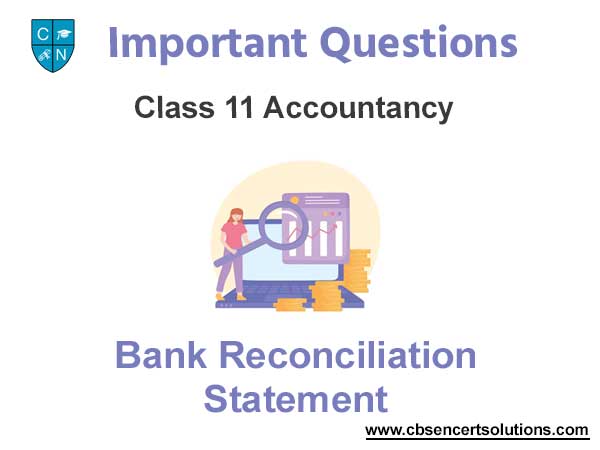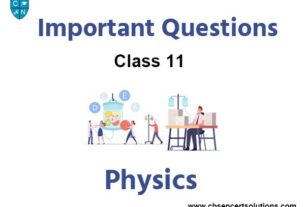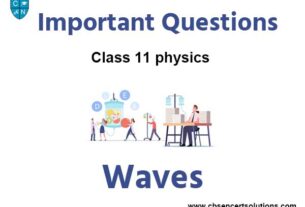Please refer to the Chapter 5 Bank Reconciliation Statement Case Study Questions with answers provided below. We have provided Case Study Questions for Class 11 Accountancy for all chapters as per CBSE, NCERT and KVS examination guidelines. These case based questions are expected to come in your exams this year. Please practise these case study based Class 11 Accountancy Questions and answers to get more marks in examinations.
Case Study Questions Chapter 5 Bank Reconciliation Statement
Case Based Questions
Read the following case study and answer questions
Vinni has joined as an intern in Elegance Ltd a FMCG company. She has joined under the accounting department. Her supervisor Ms. Mini works as an accountant in Elegance Ltd. On day 1 of her internship, Vinni is taught how to prepare a bank reconciliation statement. Vinni is completely new to the topic and wasn’t aware about the need and procedure for preparation of bank reconciliation statement. Later, Ms Mini explained her the need and procedure for preparation of bank reconciliation statement and asked her to prepare the bankreconciliation statement for Elegance Ltd for the month of March, 2021.
Question. What documents of Elegance Ltd does Vinni require for preparation of bank reconciliation statement?
(a) Cash book of Elegance Ltd
(b) Pass book of Elegance Ltd
(c) Both (a) and (b)
(d) Neither (a) nor (b)
Answer
C
Question. Using which of the following statements would Ms Mini have explained the importance of bank reconciliation statement to Vinni?
(a) It helps to assure the customer about the correctness of the bank balance shown by the pass book.
(b) It helps the management to keep a track of cheques, which have been sent to the bank for collection.
(c) Embezzlements are avoided by regular periodic reconciliation.
(d) All of the above
Answer
D
Question. How would have Ms Mini classified the reasons for differences between cash book and bank book balances?
(a) Timing differences in recording of the transactions.
(b) Errors made by the business or by the bank.
(c) Both (a) and (b)
(d) Neither (a) nor (b)
Answer
C
Question. Using which of the following statements would MsMini have explained the need of bank reconciliation statement to Vinni?
(a) To match the balances as it is generally experienced that when a comparison is made between the bank balance as shown in the firm’s cash book and the bank statement, the two balances do not tally.
(b) To find out the cash balance.
(c) To understand liquidity position of the firm.
(d) None of the above
Answer
A
Question. ‘Debit balance as per pass book and credit balance as per cash book is a favourable balance’. You are required to answer on Vinni’s behalf whether the above statement is
(a) True
(b) False
(c) Can’t say
(d) Partially true
Answer
B
Read the following case study and answer questions
On 31st March, 2021, Mr. Dua’s cash book showed a bank balance of ₹ 3,72,000. It differed with the balance shown in his pass book. A closer scrutiny revealed that there were heques issued to creditors but not yet presented to the bank for payment amounted to ₹ 72,000. Dividend of ₹ 5,000 was received by the bank but not entered in the cash book. Interest of ₹ 1,250 was allowed by the bank. Cheques of ₹ 15,400 were deposited into bank for collection but not collected by bank upto this date. Bank charges amounted to ₹ 200. A cheque of ₹ 320 deposited into bank was dishonoured but no intimation was received. Bank paid house tax of ₹ 350 on his behalf but no information was received from the bank in this connection.
Question. Difference caused due to bank charges amounting to ₹ 200, is an example of
(a) timing differences in recording of transactions.
(b) errors made by the business.
(c) errors made by the bank.
(d) None of the above
Answer
A
Question. Bank paid house tax of ₹ 350 on his behalf but no information was received from the bank will lead to
(a) balance in cash book greater than the balance of pass book.
(b) balance in cash book lesser than the balance of pass book.
(c) balance in pass book greater than the balance of cash book.
(d) None of the above
Answer
A
Question. Cheques of ₹ 15,400 were deposited into bank for collection but not collected by bank will be
(a) added to debit balance of cash book.
(b) deducted from debit balance of cash book.
(c) ignored.
(d) None of the above
Answer
B
Question. Cheques issued to creditors but not yet presented to the bank for payment amounting to ₹ 72,000 will be
(a) added to debit balance of cash book.
(b) deducted from debit balance of cash book.
(c) ignored.
(d) None of the above
Answer
A
Question. What is the balance of pass book on 31st March, 2021?
(a) ₹ 4,33,980
(b) ₹ 4,50,250
(c) ₹ 3,72,000
(d) None of these
Answer
A
Read the following case study and answer questions
On 31st December, 2021, the cash book of Mittal Bros showed a credit balance of ₹ 6,920. There is a stark difference in the balance as per pass book. A careful scrutiny points out that there was a debit by bank for ₹ 200 on account of interest on overdraft and ₹ 50 on account of charges for collecting bills. Cheques drawn but not encashed before 31st December, 2021 were for ₹ 4,000. The bank as collected interest and has credited ₹ 600 in pass book. A bill receivable for ₹ 700 previously discounted with the bank had been dishonoured and debited in the pass book . Cheques paid into bank but not collected and credited before 31st December, 2021 amounted to ₹ 6,000.
Question. While preparing the bank reconciliation statement, bills receivable for ₹ 700 previously discounted with the bank now dishonoured, will
(a) increase the credit balance of cash book.
(b) decrease the credit balance of cash book.
(c) will not affect the credit balance of cash book.
(d) None of the above
Answer
A
Question. Credit balance in cash book reflects
(a) overdraft
(b) favourable balance
(c) nil balance
(d) None of these
Answer
A
Question. What will be the balance as per pass book on 31st December, 2021?
(a) ₹ 6,920
(b) ₹ 9,270
(c) ₹ 4,570
(d) ₹ 13,870
Answer
B
Question. Credit balance of bank account as per cash book essentially means
(a) bank account becomes negative and the businesses in effect have borrowed from the bank.
(b) there is high positive balance in bank account.
(c) business has paid all its bank loans.
(d) None of the above
Answer
A
Question. While preparing the bank reconciliation statement, cheques drawn but not encashed before 31st December, 2021 for ₹ 4,000 will be
(a) added to credit balance of cash book.
(b) deducted from credit balance of cash book.
(c) ignored.
(d) None of the above
Answer
A
Read the following case study and answer questions
On 31st March, 2021, the bank pass book of Radha showed a balance of ₹ 15,000 to her credit and it differed with the balance reflected in her cash book. Before that date , she had issued cheques amounting to ₹ 8,000 out of which cheques amounting to ₹ 3,200 have so far been presented for payment. A cheque of ₹ 2,200 deposited by her into the bank on 26th March, 2021 is not yet credited in the pass book. She had also received a cheque of ₹ 500 which although entered by her in the bank column of cash book, was omitted to be paid into the bank. On 30th, March 2021, a cheque of ₹ 1,570 received by her was paid into bank but the same was omitted to be entered in the cash book. There was a credit of ₹ 150 for interest on current account and a debit of ₹ 25 for bank charges.
Question. ‘‘She had issued cheques amounting to ₹ 8,000 out of which cheques amounting to ₹ 3,200 have so far been presented for payment.’’ What will be the amount deducted from the balance of pass book to reconcile it with the balance of cash book?
(a) ₹ 8,000
(b) ₹ 3,200
(c) ₹ 4,800
(d) None of the above
Answer
C
Question. How will a credit of ₹ 150 for interest on current account be treated while preparing the bank reconciliation statement?
(a) Added to balance of pass book
(b) Deducted from balance of pass book
(c) Ignored
(d) None of the above
Answer
B
Question. As per the given case, what could be the possible reason for difference in balance of cash book and pass book?
(a) Timing differences in recording of transactions.
(b) Errors made by the business.
(c) Both (a) and (b)
(d) None of the above
Answer
C
Question. On 30th March, 2021, a cheque of ₹ 1,570 received by her was paid into bank but the same was omitted to be entered in the cash book is an example of
(a) timing differences in recording of transactions.
(b) errors made by the business.
(c) errors made by the bank.
(d) None of the above
Answer
B
Question. What will be the balance as per cash book on 31st March, 2021?
(a) ₹ 11,205
(b) ₹ 15,000
(c) ₹ 17,725
(d) None of the above
Answer
A



